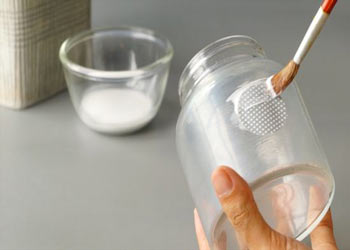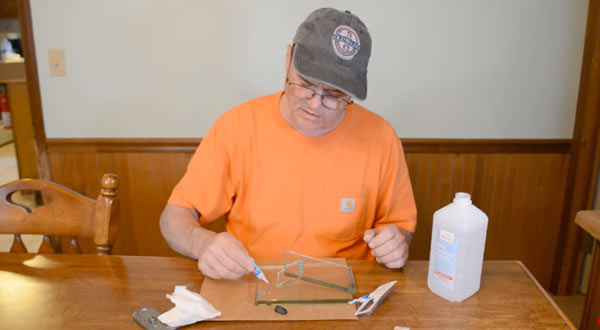How To Glue Glass Together – Easy Method Explained
Glass items are usually not durable and they tend to break. It might be your favorite vase or just a really nice showpiece.
When they break, sometimes we just have to repair that item. But the finesse depends on the process. This article is going to help on this journey.
Fixing glass is no easy task. Assessing the damage, collecting all the pieces, getting the right glue, and carefully following the instructions mentioned in this article is quite a long list of tasks.
On the bright side, it’s far from impossible. If you follow these 9 steps on how to glue glass together, your prized possession is going to look brand new.
So without further ado, let’s dive right in.
How Do You Gluing Glass Together At Home - 9 Steps Discussed

Step 1: Choosing The Right Adhesive
This is one of the most complicated parts of the process. You need to select the right kind of glue to use on your glass. You have to choose between silicone, food-safe glass, UV, Epoxy, and PUV glue.
Silicone is super effective and transparent but the caveat is that it is toxic so you can’t use it for plates and glass.
That’s where food-safe adhesives come in but they are usually much weaker than their silicone counterparts. Alternatively, you could for UV glue. Just remember you will need decent sunlight exposure for the glue to set.
Step 2: Make Sure You Are Protected
Once you’ve chosen the right glue for your job, make sure you take all the necessary precautions to keep yourself safe during the process. Glass fragments are not the safest items to work with. Injuries are likely if you aren’t careful.
Ready a space for the process and keep the surface clear so that there are no mishaps. Wear some medical tape to keep your fingers safe from the glass fragments; you don’t want any splinters to harm you.
Lastly, wear a high-quality pair of latex gloves so that you can keep your hands safe from the chemicals in the strong adhesives you will be working with.
Step 3: Collect All The Fragments
Collecting the fragments might sound easy on paper but if you’ve ever worked with broken glass, you know just how tedious and annoying this process is. You need to find all the fragments and carefully transport them to your workspace.
Why is this so tough? Well, first of all, glass has a tendency to spread when it breaks so searching for each fragment is no picnic.
On top of that, as we’re sure you’re well aware, the fragments are fragile so you might do more damage as you move them to your workspace. Be patient with this process.
Step 4: Clean The Fragments
A refreshing change of pace from the previous step, this is a really easy step. Get some dish soap and water and ready a squeaky clean piece of cloth or a high-quality sponge. Take the pieces and clean them thoroughly.
If the soap and water mixture doesn’t do the trick, use some alcohol such as acetone or mineral spirits. If the stronger solution still doesn’t cut it, get a ball of iron wool out and start scrubbing.
After this, leave the fragments to dry. Do not touch the fragment or let them come in contact with other substances. The glass needs to be oil-free for the glue to work.
Step 5: Apply The Glue To Your Fragments
For this step, you’ll be wise to follow the famous architectural philosophy of less is more. Apply a tiny amount of glue all along the edge of one of your fragments. If you apply too much glue, not only will you be in a sticky situation, you will also struggle in the next steps.
Step 6: Hold The Pieces Together
This is one of the easiest steps. Just hold the pieces together for a minute or two. The longer you hold it in place, the better the results.
Step 7: Wait For It To Dry
Again, this is another task but it does test your patience a bit. The duration of time you have to wait depends on 3 factors: what type of glue you are using, where you are leaving your item to dry, and the size and number of fragments.
For example, UV glue needs constant exposure to sunlight or a UV lamp but it does not require much time to set, a few minutes to an hour should do.
Silicone, in sharp contrast, requires no weather conditions but takes a lot of time to set. You need to leave it to rest for many hours.
Lastly, the more fragments you have or the larger the fragments, the more glue you have to use and hence the longer it takes to dry.
A pro tip here is to not put your item to use instantly after the glue dries. We suggest waiting 24 hours before applying any force to the item.
Step 8: Remove Any Excess
Even if you followed step 5 to a tee and used very little glue, there may be some leakages. If you catch these leakages early on, you can get rid of the excess using a paper towel.
If the glue has already set, you will need to use a sharp tool such as a scalpel or a razor blade to shave away the hardened glue.
Step 9: Decorate Your Glass
If you used silicone or UV adhesive, the cracks should not be visible as they dry clear. But if you used any other type of adhesive, the repairs may be visible.
If you don’t want people to see these modifications or just feel a tad bit creative, you can decorate your glass using a small layer of glue and any decorative material. Just make sure you seal it off with a sealant.
Tips And Cautions When Gluing Glass Together
Unfortunately, gluing glass is not as easy as it sounds. If there are any accidents, you could get some serious injuries. That’s why we have 3 pieces of advice for anyone looking to do this task.

1. Adult Supervision Is Necessary
This is not child’s play. Young children should not be doing this and handling some of the powerful chemicals such as UV glue or silicone. If either of those materials are used without care, there could be dire consequences. That’s why you need an adult to be present during the entire process.
2. Get High-Quality Glue
Don’t use cheap glue. If you are not willing to invest a little on the glue, it is unlikely that you can fix your item properly. This shouldn’t be an issue as branded and top-notch glue isn’t going to cost you a fortune.
3. Slow And Steady Wins The Race
Last but not least, you need to take your time with this process and for drying the glue. We’ve already talked about how risky this is but even besides that, if you make mistakes, it’s going to be very hard to get your item fixed.
Final Words
There you have it. A step-by-step process on how to glue glass together. We hope this guide was clear and each of the steps was easy to understand. We wish you luck on any future arts and crafts projects.
Also read:

